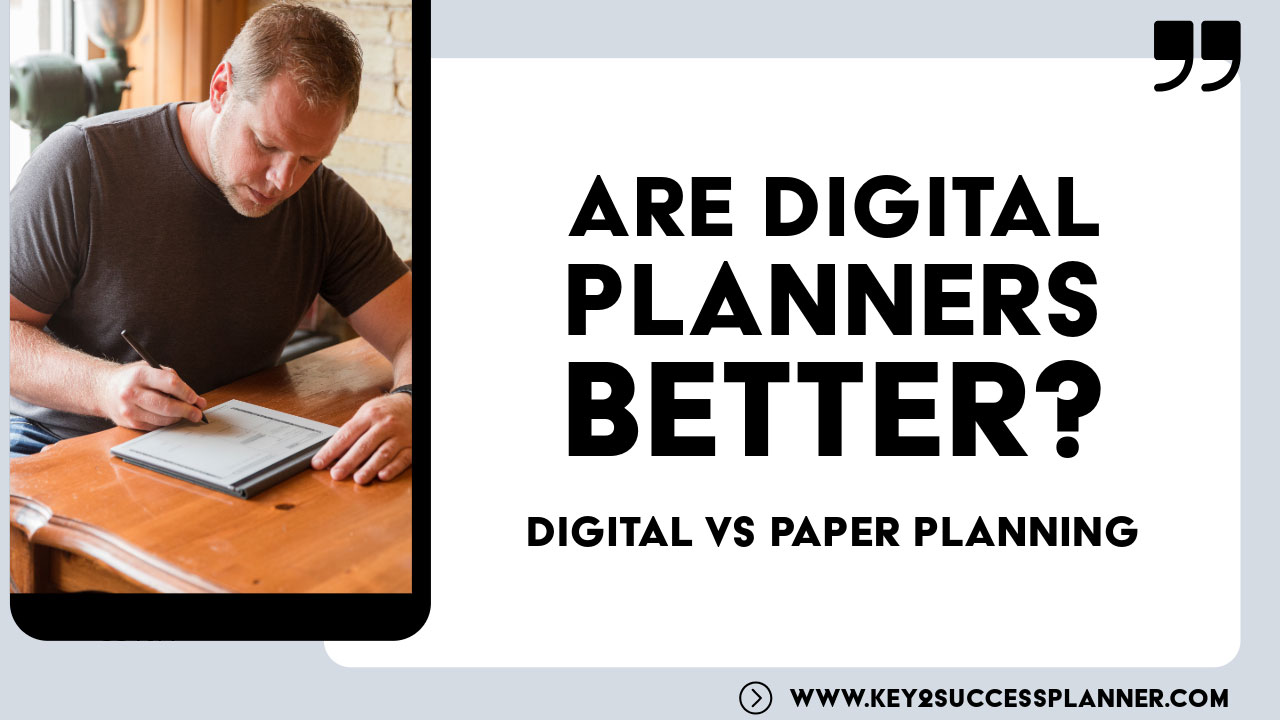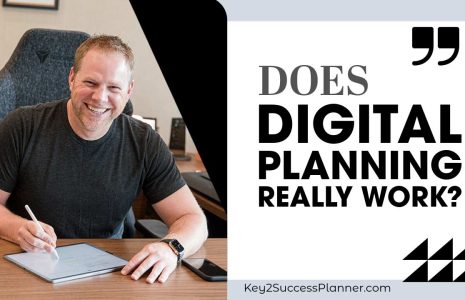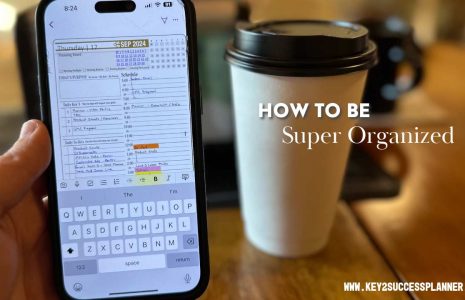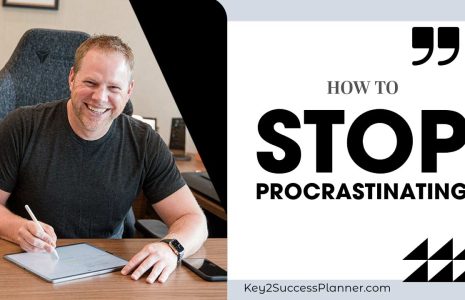Digital vs Paper Planners
Are digital planners better than paper planners? To decide, we must first take a closer look at both.
Paper Planners
A paper planner, also known as a physical planner or agenda, is a tangible, often bound book or notebook designed to help users organize their schedules, tasks, goals, and other aspects of their lives. Popular options include Franklin Covey, Michael Hyatt, and Full Focus planners.
Paper planners typically include various sections such as monthly and weekly calendars, to-do lists, goal-setting pages, note-taking areas, and sometimes additional features like habit trackers or expense trackers.
Users can manually write in appointments, events, tasks, and other information using pens, pencils, or markers. Paper planners come in various sizes, formats, and designs to cater to different preferences and needs. Some people prefer the simplicity and tactile experience of using a paper planner, finding that it helps them stay organized and focused without the distractions of digital devices.
Digital Planners
A digital planner is a digital version of a traditional paper planner that users can access and interact with using electronic devices such as smartphones, tablets, laptops, or desktop computers. Digital planners can come in various formats, including apps, software programs, or cloud-based platforms.
Are digital planners better than paper planners? Digital planners offer many of the same features as their paper counterparts, such as calendars, to-do lists, goal trackers, note-taking areas, and more. However, they provide additional benefits that leverage the capabilities of digital technology.
Visit the OneNote Planner Shop
Visit the ReMarkable Planner Shop
Visit the GoodNotes/Samsung/Scribe Shop
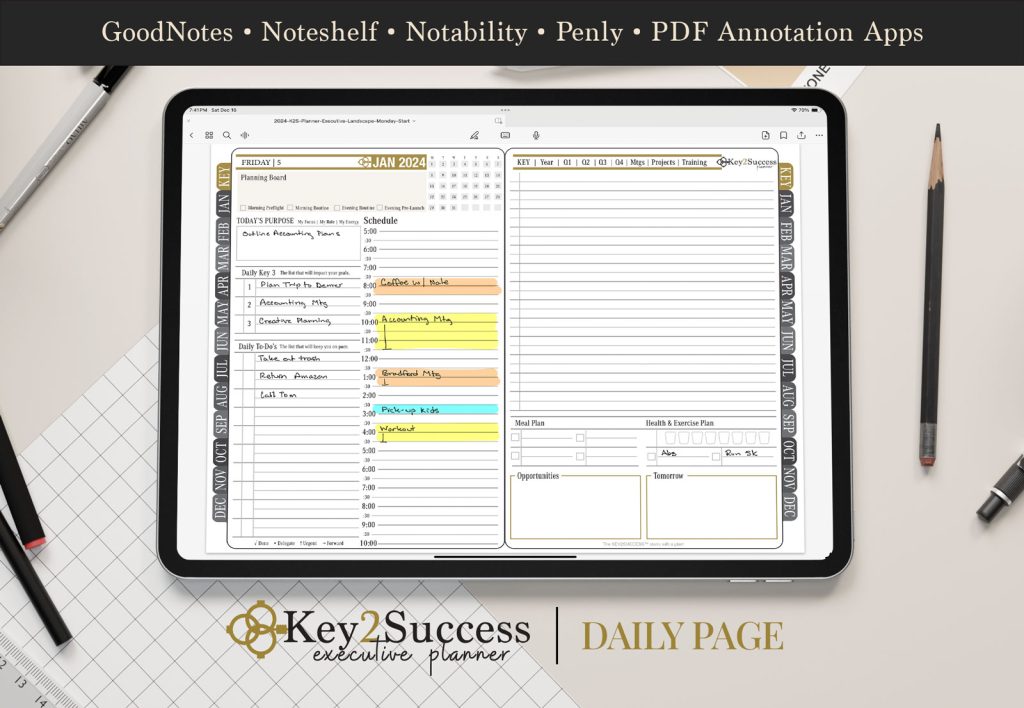
Are digital planners better than paper?
Now the big question…Are digital planners better than paper? Whether digital planners are better than paper ones depends on individual preferences, needs, and workflow, but the benefits of digital cannot be overstated.
Here are some considerations to help answer: Are digital planners better than paper planners?:
Digital Planners:
Accessibility: Digital planners can be accessed from any device with an internet connection, making them convenient for people who work across multiple devices or locations.
Customization: Many digital planners offer extensive customization options, allowing users to tailor the planner to their specific needs with different layouts, colors, and features.
Integration: Digital planners can integrate with other digital tools and applications, such as calendars, task managers, and note-taking apps, streamlining workflows and keeping all information in one place.
Searchability: Digital planners often have search functions, making it easy to find specific information or tasks quickly.
Environmentally Friendly: Using a digital planner reduces the need for paper, making it a more environmentally friendly option.
Paper Planners:
Tactile Experience: Some people prefer the tactile experience of writing by hand and find that it helps them remember tasks and information better than typing on a keyboard. If you want to go digital but just love paper, we recommend a paper-like screen cover!
Minimal Distractions: Paper planners don’t have notifications or other digital distractions, which can help some users stay focused on their tasks. Want to go digital and still have this benefit? Consider the ReMarkable. This is the most distraction-free digital tablet device out there, in our opinion.
No Battery Dependence: Paper planners don’t require batteries or charging, so they’re always available, even in situations where digital devices might not be practical or available.
Physical Backup: Paper planners serve as a physical backup in case of digital device failure or loss… but we’d argue that digital can be backed up to the cloud. So, if there’s a flood or fire, your planner is still accessible.
Ultimately, the choice between digital and paper planners comes down to personal preference… but we’re biased, obviously. We think digital planning is the way to go! There’s a solution for pretty much anyone. Start a chat with our team to find the right solution for you!
Visit the OneNote Planner Shop
Visit the ReMarkable Planner Shop
Visit the GoodNotes/Samsung/Scribe Shop
Switching from Paper to Digital
We’ve answered the question “Are digital planners better than paper?” with a resounding YES. Now what? If you are wanting to make the switch, we’re here to help.
Transitioning from a paper planner to a digital one can feel like a daunting leap, especially if you’ve relied on the traditional format for a long time. However, the process doesn’t have to be overwhelming.
Here are some steps to help make the switch smoother:
- Set Realistic Goals and Expectations: Making a significant change in your planning method takes time. Start by setting achievable goals and establish a reasonable timeline for the transition. Take it slow and transition at a pace that feels comfortable for you.
- Find the Right Accessories: Selecting the appropriate accessories can greatly enhance your digital planning experience. Invest in a suitable case, pencil, and bag that not only accommodates your device but also aligns with your daily needs. Opt for a bag that offers both comfort and style, ensuring that carrying your device becomes seamlessly integrated into your lifestyle. By having a convenient carrying mechanism with adequate storage and accessibility, you’ll reduce the chances of forgetting your planner. Additionally, using a pencil that you’re comfortable with can streamline your daily planning process. Explore our recommended accessories:
- Join a Digital Planning Community: One of the remarkable aspects of the Key2Success Planner is the vibrant community that surrounds it. With thousands of users worldwide, there’s ample opportunity to connect with individuals who have successfully transitioned from paper to digital planning. Engage with success stories and glean insights from experienced users. Social media platforms like Facebook and Reddit host digital planner groups where members share valuable tips and tricks.
- Utilize a Habit Tracker: Establishing a habit is all about consistency. Incorporate a habit tracker into your digital planner routine to monitor and reinforce your digital planning habits. The Key2Success Planner offers a habit tracker page in some versions, facilitating your transition to digital planning seamlessly. Consider adding habits such as “charge your pencil” or “spend five minutes planning” to reinforce your digital planning routine. After all, what better way to adapt to digital planning than by leveraging a digital planner to cultivate the habit?
- Allocate Daily Time for Digital Planning: Carve out dedicated time each day for digital planning to ensure its integration into your routine. Grant yourself permission to spend a few minutes daily opening your digital planner and crafting your plan. Remember, a digital planner serves not only as a scheduler but also as a tool to help you achieve your professional and personal goals. By setting aside daily time for digital planning, you’re actively investing in your productivity and success.
- Have Fun! Transitioning to a digital planner doesn’t mean sacrificing creativity. On the contrary, the digital world offers numerous opportunities to personalize and decorate your planner. Explore online marketplaces for stickers, add-ons, and other digital embellishments to make your planner uniquely yours.
Remember, adapting to a digital planner might take some getting used to, but don’t be discouraged. With patience, experimentation, and a willingness to learn, you’ll soon find your groove in the digital planning world.
Visit the OneNote Planner Shop
Visit the ReMarkable Planner Shop
Visit the GoodNotes/Samsung/Scribe Shop
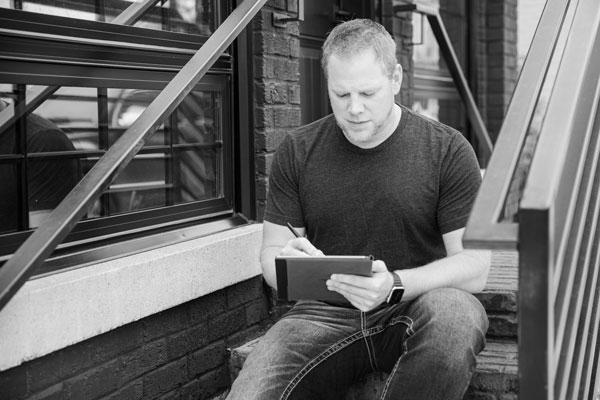
I hope we helped answer “Are digital planners better than paper planners?” Want to learn about other topics? Let us know! – Branden


